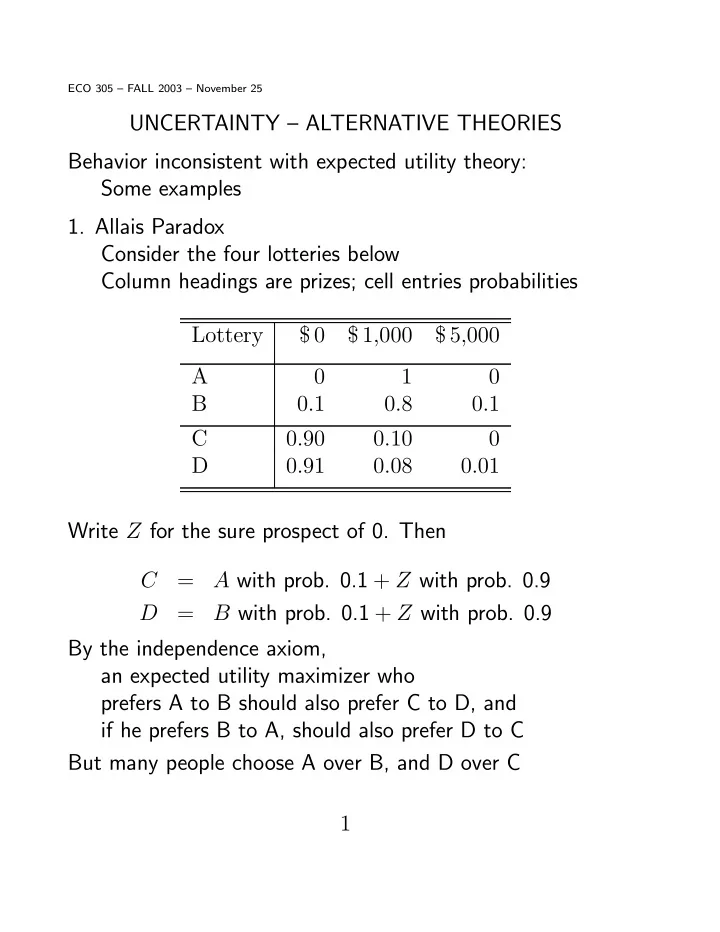

ECO 305 — FALL 2003 — November 25 UNCERTAINTY — ALTERNATIVE THEORIES Behavior inconsistent with expected utility theory: Some examples 1. Allais Paradox Consider the four lotteries below Column headings are prizes; cell entries probabilities Lottery $ 0 $ 1,000 $ 5,000 A 0 1 0 B 0.1 0.8 0.1 C 0.90 0.10 0 D 0.91 0.08 0.01 Write Z for the sure prospect of 0. Then C = A with prob. 0.1 + Z with prob. 0.9 D = B with prob. 0.1 + Z with prob. 0.9 By the independence axiom, an expected utility maximizer who prefers A to B should also prefer C to D, and if he prefers B to A, should also prefer D to C But many people choose A over B, and D over C 1
2. Kinked Utility U(W) W W0 vN-M type utility but with kink at initial wealth Values losses from status quo much more than gains 3. Minimizing maximum regret When comparing choices A and B, regret of A is i ∈ Scenarios max( U i ( B ) − U i ( A ) , 0 ) max 4. Errors in calculating probabilities Treating small probability events as if impossible Not applying correct Bayes’ rule when updating probabilities given some information Expected utility approach still dominates in most applications — fi nance, game theory etc. But alternatives being explored at research level 2
DEMAND FOR INSURANCE Loss L in scenario 2 (prob. π 2 ) Endowments ( W 0 , W 0 − L ) Each dollar of coverage requires insurance premium p If insurance is actuarially (statistically) fair, p = π 2 . If buy X dollars of coverage, fi nal wealths W 1 = W 0 − p X, W 2 = W 0 − L − p X + X Choose X to maximize EU ( W ) = π 1 U ( W 0 − p X ) + π 2 U ( W 0 − L + (1 − p ) X ) FONC − p π 1 U 0 ( W 0 − p X )+(1 − p ) π 2 U 0 ( W 0 − L +(1 − p ) X ) = 0 SOSC is U 00 < 0 , risk-aversion. If fair insurance ( p = π 2 , 1 − p = π 1 ) FONC becomes: U 0 ( W 0 − p X ) = U 0 ( W 0 − L + (1 − p ) X ) , W 1 = W 2 so risk is eliminated — full coverage X = L optimum Ins. Co.’s expected pro fi t E Π = p X − π 2 X , so fair insurance will be available if: (1) Risk-neutral insurers (by law of large nos ?) (2) Perfect competition among insurers ⇒ E Π = 0 (2) No (minimal) admin. costs, no info. asymmetry 3
Alternative view: eliminate X from W 1 , W 2 equations: (1 − p ) W 1 + p W 2 = (1 − p ) W 0 + p ( W 0 − L ) Budget constraint for “contingent claims to dollars” Prices p , (1 − p ) . Slope = (1 − p ) /p Subject to this, max EU = π 1 U ( W 1 ) + π 2 U ( W 2 ) Probabilities must be exogenous for symmetric info. W 2 45-deg EU contours (W 0 , W 0 - L ) W 1 If insurance is fair, p = π 2 slope of budget line = 45-degree-line-MRS so tangency (optimum) at 45-degree-line If “unfair” (loaded) insurance, p > π 2 slope of budget line < 45-degree-line-MRS Less than full insurance is optimal 4
TRADING RISK IN MARKETS Markets held before uncertainty is resolved Buy/sell “contingent claims”, like betting slips Simplest of these — Arrow-Debreu Securities (ADS) Basic or elementary scenarios i = 1 , 2, . . . n ADS i is claim to $1 if scenario i , nothing otherwise Prices p i paid in advance If money can be stored between now and time when uncertainty resolved and claims settled, P i p i = 1 If sure int. rate r between now and then, = 1 / (1 + r ) Equilibrium prices p i depend on probabilities π i and on extent of, and attitudes toward, the risks EXAMPLE 1 — No aggregate risk Individual risk can be fully insured by trade at fair prices Two scenarios Total W same in both Objective Probs. (1/2 each) B more risk-averse than R But MRS on 45-degree π 1 / π 2 = 1 for both So eqm. on that line p 1 /p 2 = π 1 / π 2 5
EXAMPLE 2 — Aggregate risk Total W 1 > W 2 : Scenario 1 “good”, 2 “bad” Objective probabilities π 1 , π 2 Pareto e ffi ciency, Core, Equil’m as in GE Theory (Wk.7) ADS’s achive e ffi cient allocation of risk ! B is more risk-averse than R — so e ffi cient points are relatively closer to B’s 45-degree line At any e ffi cient risk-allocation, p 1 /p 2 < π 1 / π 2 Di ff erence depends on risk-aversions of traders If one is risk-neutral, p 1 /p 2 = π 1 / π 2 6
Recommend
More recommend